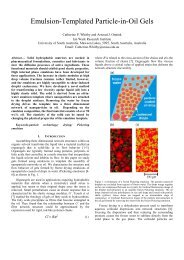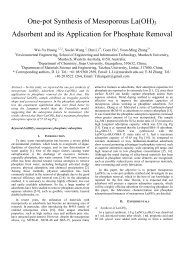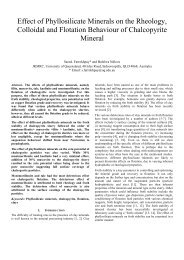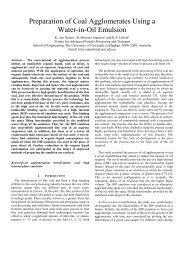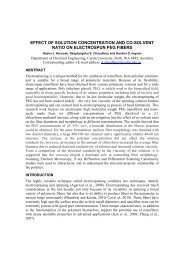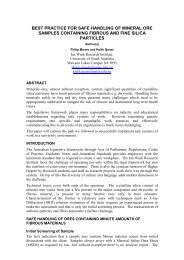Pyrite-Gold Recovery in Copper Rougher Flotation Tailings
Pyrite-Gold Recovery in Copper Rougher Flotation Tailings
Pyrite-Gold Recovery in Copper Rougher Flotation Tailings
- No tags were found...
Create successful ePaper yourself
Turn your PDF publications into a flip-book with our unique Google optimized e-Paper software.
<strong>Pyrite</strong>-<strong>Gold</strong> <strong>Recovery</strong> <strong>in</strong> <strong>Copper</strong> <strong>Rougher</strong> <strong>Flotation</strong><br />
Tail<strong>in</strong>gs<br />
Eic Am<strong>in</strong>artey Agorhom 1 , William Sk<strong>in</strong>ner and Massimiliano Zan<strong>in</strong><br />
1 Ian Wark Research Institute<br />
Ian Wark Research Institute, The ARC Special Research Centre for Particle and Interfaces, University of South<br />
Australia, Mawson Lakes Campus, Adelaide, SA 5095, Australia<br />
Email: Am<strong>in</strong>artey.Agorhom@mymail.unisa.edu.au<br />
Abstract— The present study <strong>in</strong>vestigates the effect of<br />
regr<strong>in</strong>d<strong>in</strong>g and aeration on the separation of pyrite from<br />
gold <strong>in</strong> copper rougher flotation tail<strong>in</strong>gs (0.07% Cu,<br />
0.61g/t Au, tail grades). An aeration stage was applied both<br />
at the head of copper flotation (copper rougher feed) and<br />
after regr<strong>in</strong>d<strong>in</strong>g of the copper rougher tail<strong>in</strong>gs, before<br />
gold/pyrite selective flotation. Also, different collector<br />
regimes, <strong>in</strong>volv<strong>in</strong>g sodium iso-butyl xanthate (SIBX) and<br />
N-butoxycarbonyl-nbutyl thionocarbamate (XD5002),<br />
have been tested. It was found that aeration of the copper<br />
rougher feed produced lower gold (71%) and copper<br />
(95%) recoveries than the non-aeration of the copper<br />
rougher feed (73% Au and 98% Cu recoveries). F<strong>in</strong>e<br />
regr<strong>in</strong>d<strong>in</strong>g of the copper rougher tails <strong>in</strong>creased both gold<br />
and copper recoveries <strong>in</strong> the subsequent flotation stage,<br />
due to improved liberation. The highest gold recovery<br />
from the rougher tail<strong>in</strong>gs (45%) was achieved without<br />
aeration of the reground product. However, <strong>in</strong> these<br />
conditions poor rejection of pyrite was achieved, and the<br />
concentrate gold grade was low (1.3 g/t, versus 2.3 g/t<br />
obta<strong>in</strong>ed after aerat<strong>in</strong>g the pulp). With respect to the<br />
collector scheme, <strong>in</strong>creased gold and copper recoveries<br />
were achieved blend<strong>in</strong>g the two collectors (SIBX and<br />
XD5002) compared to XD5002 alone. However, higher<br />
gold (3.0 g/t) and copper (1.0%) grades were observed with<br />
XD5002 alone, due to better pyrite rejection. This is<br />
believed to be due to the high aff<strong>in</strong>ity of xanthates (e.g.,<br />
SIBX) for the copper activated pyrite.<br />
Keywords: Depression; Aeration; Regr<strong>in</strong>d<strong>in</strong>g, <strong>Pyrite</strong>,<br />
<strong>Gold</strong>; <strong>Flotation</strong><br />
I. INTRODUCTION<br />
Froth flotation is a widely used separat<strong>in</strong>g technique for the<br />
recovery of Cu and Au <strong>in</strong> porphyry copper-gold ores. In these<br />
ores, chalcopyrite and gold are the ma<strong>in</strong> valuable m<strong>in</strong>eral/metal<br />
phases, with pyrite be<strong>in</strong>g the key sulphide gangue m<strong>in</strong>eral.<br />
However, <strong>in</strong> these ores gold is mostly associated with pyrite<br />
rather than the copper m<strong>in</strong>erals. <strong>Gold</strong>-pyrite and chalcopyritepyrite<br />
associations are problematic <strong>in</strong> porphyry copper-gold<br />
flotation due to the requirement to m<strong>in</strong>imise sulphur content<br />
(improve concentrate grade) <strong>in</strong> the f<strong>in</strong>al Cu concentrate. For<br />
example, <strong>in</strong> most Cu-Au flotation plants (i.e. Telfer gold m<strong>in</strong>e,<br />
OK Tedi, Freeport Indonesia, etc.), <strong>in</strong> order to <strong>in</strong>crease Cu and<br />
Au grades, regr<strong>in</strong>d<strong>in</strong>g and depression strategies are used to<br />
maximise pyrite rejection <strong>in</strong> the cleaner stage. Although these<br />
depression strategies improve recovery and grade of copper,<br />
gold recovery is very often affected due to its f<strong>in</strong>e-<strong>in</strong>clusions<br />
(~1-3 µm) <strong>in</strong> pyrite and non-sulphide gangue m<strong>in</strong>erals [1].<br />
Also, selectivity between chalcopyrite and pyrite <strong>in</strong> Cu-Au<br />
ores is a challenge due to un<strong>in</strong>tentional activation of pyrite as a<br />
result of the dissolution of Cu 2+ or Pb 2+ ion from complex<br />
sulphides (i.e. Cp and galena, respectively) and its association<br />
with pyrite as f<strong>in</strong>e complex <strong>in</strong>tergrowths. It has been proposed<br />
that activation of pyrite occurs as an ion exchange process,<br />
where Fe(II) is replaced by Cu(II) on the pyrite surface [2-4].<br />
The presence of Cu on pyrite promotes its <strong>in</strong>teraction with<br />
generic sulphide collectors such as xanthate. It was observed<br />
that <strong>in</strong> the presence of xanthate, dixanthogen is the ma<strong>in</strong><br />
xanthate species responsible for the flotation of Cu-activated <strong>in</strong><br />
alkal<strong>in</strong>e medium. Dixanthogen form as a result of anodic<br />
oxidation of xanthate at the surface of pyrite coupled with<br />
cathodic reduction of oxygen [5-6]. Consequently, the<br />
un<strong>in</strong>tentional pyrite flotation is undesirable <strong>in</strong> a Cu-Au ore<br />
flotation circuit due to the detrimental effect on Cu f<strong>in</strong>al grade.<br />
Therefore, <strong>in</strong> order to improve f<strong>in</strong>al concentrate grade, pyrite<br />
depression strategies (e.g. aeration, sulphite, cyanide addition,<br />
etc.) have been used over the years to m<strong>in</strong>imise pyrite<br />
recovery.<br />
In our previous study [7], the <strong>in</strong>fluence of Au m<strong>in</strong>eralogy<br />
on its flotation was studied <strong>in</strong> a typical copper ore. A two-stage<br />
(Cu and pyrite) rougher flotation <strong>in</strong>dicated that maximum Au<br />
recovery (95%) can only be achieved with pyrite flotation<br />
(recovery, 93%). A decrease <strong>in</strong> gr<strong>in</strong>d size of the flotation feed<br />
from 70 µm to 38 µm and without pyrite flotation stage<br />
resulted <strong>in</strong> a decreased Au recovery (73%) due to depression of<br />
pyrite/gold composites (pH 11.5). Therefore, it is crucial to<br />
study how regr<strong>in</strong>d<strong>in</strong>g of Cu tails at f<strong>in</strong>er gr<strong>in</strong>d (p80 = 15 µm)<br />
and aeration can be used to maximise Au recovery and grade<br />
while still reject<strong>in</strong>g significant pyrite. Regr<strong>in</strong>d<strong>in</strong>g <strong>in</strong> the stirred<br />
mill (IsaMill) does not only reduce particle size, but also<br />
liberate Au and Cu from the pyrite m<strong>in</strong>eral, and expose new<br />
surfaces for enhanced collector adsorption.<br />
In this study, the effect of aeration (both at the head of Cu<br />
flotation and after regr<strong>in</strong>d<strong>in</strong>g of copper rougher tail<strong>in</strong>gs) on the<br />
flotation behaviour of Au and Cu <strong>in</strong> a porphyry copper-gold is<br />
exam<strong>in</strong>ed <strong>in</strong> detail. <strong>Copper</strong> rougher and scavenger flotation<br />
1
tests were performed by collector (SIBX/XD5002) addition <strong>in</strong><br />
stages. Consequently, the flotation behaviour of Cu, Au and<br />
pyrite was exam<strong>in</strong>ed on the basis of recovery and grade as well<br />
as the mechanisms responsible for pyrite depression/rejection<br />
us<strong>in</strong>g EDTA extraction techniques.<br />
A. Materials<br />
II.<br />
EXPERIMENTALS<br />
A.I. Ore<br />
M<strong>in</strong>eralogical characterisation of the ore revealed that<br />
chalcopyrite and covellite were the major copper-bear<strong>in</strong>g<br />
m<strong>in</strong>erals. <strong>Pyrite</strong> and silicates were identified as the ma<strong>in</strong> gold<br />
host m<strong>in</strong>erals <strong>in</strong> the ore. <strong>Gold</strong> occurred as either liberated or<br />
locked <strong>in</strong> pyrite, sphalerite or biotite. Chemical analysis<br />
showed that the ore conta<strong>in</strong>ed 1.7 g/t Au, 1.0% Cu, 12.6% S<br />
and 18.4% Fe.<br />
A.II. Reagents<br />
The collectors used were sodium iso-butyl xanthate<br />
(C4H9OCSSNa, abbreviated SIBX) and N-butoxycarbonyl-n<br />
butyl thionocarbamate (R’HN-(C=S)-OR”, abbreviated XD-<br />
5002), supplied by Cytec Chemicals. The frother used was<br />
methyl-iso-butyl carb<strong>in</strong>ol (MIBC), also supplied by Cytec<br />
Chemicals. All the reagents were freshly prepared for each<br />
experiment as 1% w/w solutions. Lime was used as pH<br />
modifier and compressed air as flotation gas (2 L/m<strong>in</strong>).<br />
B. Methods<br />
B.I. Gr<strong>in</strong>d<strong>in</strong>g, aeration and flotation<br />
The schematic representation of the experimental<br />
procedure is shown <strong>in</strong> Fig. 1. The ore (2 kg crushed to -2 mm)<br />
was ground for 60 m<strong>in</strong> <strong>in</strong> a closed sta<strong>in</strong>less steel Galigher<br />
mill, <strong>in</strong> 1000 ml of dem<strong>in</strong>eralised water, add<strong>in</strong>g 2.5 g/t<br />
XD5002 and 1.0 g of dry lime. This resulted <strong>in</strong> a flotation feed<br />
with 80 wt.% of the particles pass<strong>in</strong>g through 38 µm screen<br />
(p80=38 µm) and a mill discharge at pH 9.0. After gr<strong>in</strong>d<strong>in</strong>g,<br />
the pulp was transferred to a 4.5 L Denver flotation cell. Two<br />
conditions, aeration and non-aeration were applied to the pulp<br />
before reagent condition<strong>in</strong>g.<br />
In the first set, the pulp was aerated for 25 m<strong>in</strong> before<br />
SIBX and XD5002 were added <strong>in</strong> six stages. The total<br />
flotation time was 15 m<strong>in</strong> and the pulp pH was kept constant<br />
at 11.5. After Cu rougher flotation, the tails were reground<br />
with batch stirred mill (IsaMill) to produce a flotation feed of<br />
p80=15 µm. <strong>Copper</strong> scavenger tests were conducted with 15<br />
g/t SIBX, 10 g/t XD5002 and 7.5 g/t MIBC. Two m<strong>in</strong>utes time<br />
(2 m<strong>in</strong>) was allowed for each condition<strong>in</strong>g. Four concentrates<br />
were collected at 1, 2, 4 and 8 m<strong>in</strong> cumulatively. The detailed<br />
test conditions for the Cu rougher and scavenger stages are<br />
shown <strong>in</strong> Table 1.<br />
TABLE I. FLOTATION TEST CONDITIONS OF THE<br />
Cu ROUGHER AND SCAVENGER STAGES<br />
Cu rougher stage<br />
Cu scavenger stage<br />
Pulp density (30 wt.% solids) Regr<strong>in</strong>d<strong>in</strong>g (for 35 m<strong>in</strong> <strong>in</strong> IsaMill)<br />
Pulp volume (4.5L)<br />
Pulp density (20 wt.% solids)<br />
Agitator speed (1200 rpm)<br />
Pulp volume (2.0L)<br />
pH (11.5)<br />
Agitator speed (1000 rpm)<br />
Total flotation time, 15 m<strong>in</strong> ( 2.5 m<strong>in</strong> Total flotation time (8 m<strong>in</strong>)<br />
for each stage)<br />
All tests were carried out <strong>in</strong> duplicates. At the end of each<br />
test, concentrate and tail samples were filtered, dried at 60 0 C<br />
and assayed for Cu, Au, S and Fe. The flotation strategies<br />
employed to optimise gold recovery whiles reject<strong>in</strong>g<br />
significant pyrite <strong>in</strong> the copper tail are shown <strong>in</strong> Table 2.<br />
Feed<br />
60 m<strong>in</strong><br />
Air (5 L/m<strong>in</strong>)<br />
25 m<strong>in</strong><br />
d 80=38 µm<br />
No<br />
aeration<br />
<strong>Rougher</strong><br />
block<br />
d 80 = 15 µm<br />
Scavenger blocks<br />
Regr<strong>in</strong>d<br />
Circuit<br />
Cu rougher<br />
concentrate<br />
Air (5 L/m<strong>in</strong>)<br />
25 m<strong>in</strong><br />
F<strong>in</strong>al Tails<br />
Figure 1. Simplified Flowsheet show<strong>in</strong>g flotation with and without aeration of<br />
Cu rougher feed.<br />
2
TABLE II. TEST CONDITIONS FOR Au REOVERY OPTIMISATION IN<br />
THE COPPER ROUGHER TAILS<br />
Cu feed aerated (IsaMill<br />
regr<strong>in</strong>d<strong>in</strong>g, p80=15 µm)<br />
Test1: Aerated for 25 m<strong>in</strong> and<br />
floated for 8 m<strong>in</strong> us<strong>in</strong>g<br />
SIBX/XD5002<br />
Test1-1: Aerated for 50 m<strong>in</strong> and<br />
floated us<strong>in</strong>g SIBX/XD5002<br />
A.III. EDTA extraction technique<br />
Cu feed non-aerated (IsaMill<br />
regr<strong>in</strong>d<strong>in</strong>g, p80=15 µm)<br />
Test 2: Non-aerated and floated for<br />
8 m<strong>in</strong> us<strong>in</strong>g SIBX/XD5002<br />
Test 3: Aerated for 25 m<strong>in</strong> and<br />
floated for 8 m<strong>in</strong> us<strong>in</strong>g<br />
SIBX/XD5002<br />
Test 3-1: Aerated for 50 m<strong>in</strong> and<br />
floated us<strong>in</strong>g SIBX/XD5002<br />
Test 3-2: Aerated for 25 m<strong>in</strong> and<br />
floated for 8 m<strong>in</strong> us<strong>in</strong>g XD5002<br />
Ethylene diam<strong>in</strong>etetraacetic acid (EDTA) was used to<br />
extract metal oxidation products (e.g. oxide/hydroxide,<br />
sulphate, carbonate, etc.) from the m<strong>in</strong>eral surfaces [8-10]. A<br />
pulp volume of 0.1dm 3 was mixed with a 3% AR grade of<br />
EDTA solution and conditioned for 5 m<strong>in</strong> while purg<strong>in</strong>g with<br />
nitrogen to prevent further oxidation of the m<strong>in</strong>eral surface.<br />
The EDTA solution was purged with nitrogen for 10 m<strong>in</strong><br />
before extraction to remove residual oxygen. The amount of<br />
surface oxidation products extracted by EDTA was measured<br />
<strong>in</strong> solution by <strong>in</strong>ductively coupled plasma mass spectroscopy<br />
(ICP-MS).<br />
A. Results<br />
III.<br />
RESULTS AND DISCUSSION<br />
A.I. Effect of aeration and liberation<br />
The effect of aeration on gold flotation <strong>in</strong> the copper<br />
rougher stage is shown <strong>in</strong> Fig.2. It can be seen that the highest<br />
recovery (82%) was achieved at the expense of grade (5.7 g/t)<br />
when the copper rougher feed was not pre-aerated before<br />
flotation. This is because such condition promotes pyrite<br />
flotation which <strong>in</strong>variably leads to higher gold recovery s<strong>in</strong>ce<br />
the majority of the unliberated gold particles were associated<br />
with pyrite as f<strong>in</strong>e <strong>in</strong>clusions (~1-3µm) [1, 7]. Although higher<br />
gold grade (7.6 g/t) was achieved when the copper rougher<br />
feed was pre-aerated before flotation, the gold flotation<br />
recovery (71%) and k<strong>in</strong>etics were low.<br />
<strong>Gold</strong> recovery (%)<br />
100<br />
80<br />
60<br />
40<br />
20<br />
(a)<br />
0<br />
0 2 4 6 8 10 12 14<br />
<strong>Flotation</strong> time (m<strong>in</strong>)<br />
Aerated Cu rougher feed<br />
Non-aerated Cu rougher feed<br />
Cum. <strong>Gold</strong> <strong>Recovery</strong> (%)<br />
85<br />
80<br />
75<br />
70<br />
65<br />
60<br />
55<br />
50<br />
5 6 7 8 9 10 11 12 13<br />
Cum. <strong>Gold</strong> Grade (%)<br />
Cu rougher feed aerated<br />
Cu feed non-aerated<br />
Figure 2. Effect of aeration condition on (a) gold flotation rates and (b)<br />
gold flotation behaviour <strong>in</strong> different test conditions (Cu rougher feed aerated<br />
and non-aerated) us<strong>in</strong>g SIBX/XD5002 as collector, p80=38 µm.<br />
However, when the copper rougher tails (Test 1, Test 2 and<br />
Test 3) were reground, only 25% of the total gold lost was<br />
recovered <strong>in</strong> Test 1. Test 2 showed the highest gold recovery<br />
(45%), due to higher pyrite recovery (45%) (Table 3). When<br />
the reground product of Test 3 was pre-aerated before flotation,<br />
about 33% of gold was recovered at an improved grade (2.3<br />
g/t). Also, the highest gold (86%) and copper (98%) recoveries<br />
<strong>in</strong> the comb<strong>in</strong>ed copper rougher and scavenger stage was<br />
achieved when aeration was not applied both at the head of<br />
copper flotation and after regr<strong>in</strong>d<strong>in</strong>g of the copper rougher<br />
tail<strong>in</strong>gs.<br />
TABLE III. FLOTATION DATA FOR Au, Cu AND Py AFTER<br />
REGRIND TO p80=15µm UNDER DIFFERENT TEST CONDITIONS (Au,<br />
Rec ±2%, Cu, Rec ±1% and Py, Rec ±4%)<br />
Test #<br />
<strong>Recovery</strong><br />
(%)<br />
(b)<br />
<strong>Gold</strong> <strong>Copper</strong> <strong>Pyrite</strong><br />
Grade<br />
(g/t)<br />
Error bar<br />
<strong>Recovery</strong><br />
(%)<br />
Grade<br />
Total Recoveries,<br />
% (Cu Ro+Sc<br />
stage)<br />
In case of copper flotation, there was no significant change<br />
<strong>in</strong> copper recovery for the two different test conditions (Fig.3).<br />
The best copper grade (7.3%) was achieved when the copper<br />
rougher feed was pre-aerated before flotation. It has been<br />
demonstrated by a number of researchers that flotation of<br />
copper m<strong>in</strong>erals such as chalcopyrite improved at higher pulp<br />
potential, ~300 mV [11-12]. This is evident <strong>in</strong> the flotation of<br />
the reground product of Test 3, where maximum copper grade<br />
(0.8%) was achieved as a result of significant reduction <strong>in</strong><br />
pyrite recovery (16%) as compared to Test 2 (Table 3).<br />
Although copper recoveries were not significantly affected<br />
compared to the basel<strong>in</strong>e flotation studies [7], copper flotation<br />
rate was slower when copper rougher feed was pre-aerated<br />
before flotation (Fig.3). This condition promotes the formation<br />
of metal hydroxide species on the surface of chalcopyrite<br />
which makes the formation of metal xanthate on the<br />
chalcopyrite surface difficult result<strong>in</strong>g <strong>in</strong> slower flotation rates<br />
(%)<br />
<strong>Recovery</strong><br />
(%)<br />
Grade<br />
Test 1 25 2.2 43 0.6 10 24.5 73 96 36<br />
Test 2 45 1.7 54 0.3 45 54.3 86 98 62<br />
Test 3 33 2.3 56 0.8 16 32.4 82 97 49<br />
(%)<br />
Au<br />
%<br />
Cu<br />
%<br />
Py<br />
%<br />
3
<strong>in</strong> flotation [13]. Higher pyrite rejection (about 64%) was<br />
observed when both copper rougher feed and reground product<br />
were aerated before flotation, but this caused a significant<br />
reduction <strong>in</strong> gold recovery. The significant pyrite<br />
rejection/depression correlate with higher oxygen consumption<br />
rate (kla = 0.131 m<strong>in</strong> -1 ) of the reground product determ<strong>in</strong>ed<br />
from oxygen demand test (not shown here). The pulp potential<br />
(Eh) <strong>in</strong>crease steadily from 269 to 342 mV SHE after aeration,<br />
which may be responsible for the effective pyrite depression<br />
under this test condition (Table 4).<br />
TABLE IV. PULP CHEMISTRY PARAMETERS (DO & Eh) AND<br />
OXYGEN CONSUMPTION RATE, kla AFTER AERATION OF<br />
REGROUND PRODUCT (TEST 1), p80 = 15 µm.<br />
Pulp parameters Initial F<strong>in</strong>al<br />
DO (ppm) 2.72 7.76<br />
Eh (mV SHE) 269 342<br />
Cum. <strong>Copper</strong> <strong>Recovery</strong> (%)<br />
<strong>Gold</strong> recovery (%)<br />
100<br />
98<br />
96<br />
94<br />
92<br />
90<br />
88<br />
86<br />
84<br />
82<br />
100<br />
80<br />
60<br />
40<br />
20<br />
Aerated Cu rougher feed<br />
Non-aerated Cu rougher feed<br />
0<br />
0 2 4 6 8 10 12 14<br />
<strong>Flotation</strong> time (m<strong>in</strong>)<br />
Cu rougher feed aerated<br />
Cu rougher feed non-aerated<br />
80<br />
4 6 8 10 12 14<br />
100<br />
(a)<br />
(b)<br />
Error bar<br />
Cum. <strong>Copper</strong> Grade (%)<br />
Kla (m<strong>in</strong> -1 ) 0.131 0.029<br />
A.II. Effect of aeration time and collector suite<br />
Increase <strong>in</strong> aeration time from 25 m<strong>in</strong> to 50 m<strong>in</strong> for the<br />
reground products of Test 1 and Test 3 resulted <strong>in</strong> decreased<br />
gold, copper and pyrite recoveries. When the aeration time for<br />
Test 1 was <strong>in</strong>creased, total gold recovery decreased from 73%<br />
to 70% with an improved overall gold concentrate grade (8.5<br />
g/t) (Table 5). A similar reduction <strong>in</strong> copper and pyrite<br />
recoveries were observed <strong>in</strong> Test 1-1. However, copper grade<br />
(7.2%) improved significantly as a result of drastic reduction <strong>in</strong><br />
mass recovery. Also, <strong>in</strong>crease <strong>in</strong> aeration time for the reground<br />
product for Test 3 showed a decreased gold recovery (81%) but<br />
did not impact on gold grade (5.4 g/t) (Test 3-1). There was no<br />
significant change <strong>in</strong> copper recovery but copper grade<br />
<strong>in</strong>creased by 0.2%. <strong>Pyrite</strong> and mass recoveries reduced<br />
significantly.<br />
A change <strong>in</strong> collector suite, from a comb<strong>in</strong>ation of SIBX<br />
and XD5002 to only XD5002 (a more Cu-sulphide selective<br />
collector) for Test 3 reground product (Test 3-2) resulted <strong>in</strong> a<br />
reduction <strong>in</strong> gold recovery from 83% to 76% at an improved<br />
grade (7.4%). <strong>Copper</strong> recovery also dropped marg<strong>in</strong>ally, by<br />
1%. However, copper grade <strong>in</strong>creased significantly (6.8%).<br />
The change <strong>in</strong> collector suite has more significant impact on<br />
pyrite rejection than <strong>in</strong>creas<strong>in</strong>g the aeration time of the<br />
reground product (Test 3-1) (Table 5).<br />
<strong>Pyrite</strong> recovery (%)<br />
80<br />
60<br />
40<br />
20<br />
(c)<br />
Aerated Cu rougher feed<br />
Non-aerated Cu rougher feed<br />
TABLE V. FLOTATION RECOVERY AND GRADE DATA FOR Au,<br />
Cu AND Py IN THE COMBINED ROUGHER AND SCAVENGER STAGES<br />
(Au, Rec ±2%, Grade ±0.08g/t; Cu, Rec ±1%, Grade ±0.05% and Py, Rec<br />
±4%, Grade ±3%)<br />
Test #<br />
<strong>Recovery</strong><br />
(%)<br />
<strong>Gold</strong> <strong>Copper</strong> <strong>Pyrite</strong> Mass<br />
Grade<br />
(g/t)<br />
<strong>Recovery</strong><br />
(%)<br />
Grade<br />
(%)<br />
<strong>Recovery</strong><br />
(%)<br />
Grade<br />
(%)<br />
Yield<br />
Test 3 82 5.4 97 5.7 49 41.9 31±2<br />
(%)<br />
0<br />
0 2 4 6 8 10 12 14<br />
<strong>Flotation</strong> time (m<strong>in</strong>)<br />
Figure 3. Effect of aeration on (a) copper flotation rates; (b) copper<br />
flotation behaviour and (c) pyrite flotation rates <strong>in</strong> different test conditions<br />
us<strong>in</strong>g SIBX/XD5002 as collector, p80=38 µm.<br />
Test 3-1 81 5.4 97 5.9 28 38.4 29±2<br />
Test 3-2 76 7.6 96 6.8 29 37.7 18±2<br />
Test 1 73<br />
5.7<br />
96 5.2 36 36.9 24±2<br />
Test 1-1 70 8.5 94 7.2 24 37.7 15±2<br />
4
A.III. Effect of surface species<br />
To account for the differences <strong>in</strong> pyrite recovery for the<br />
aerated and no-aerated Cu rougher feed, EDTA extraction was<br />
performed on the feed, primary ground product and after<br />
aeration. Table 6 shows the amount of Cu, S and Fe oxidation<br />
species extracted. The results <strong>in</strong>dicate that the concentration of<br />
surface Cu and Fe oxidation species <strong>in</strong> the feed was relatively<br />
low compared to the primary ground product. The EDTA<br />
extractable Cu and Fe <strong>in</strong>creased approximately from 19 and<br />
2% (feed) to 23 and 4%, respectively, after primary gr<strong>in</strong>d<strong>in</strong>g.<br />
The observed <strong>in</strong>crease <strong>in</strong> Cu and Fe concentration after<br />
primary gr<strong>in</strong>d<strong>in</strong>g at high pH suggests the formation of more<br />
Cu(OH) 2 and Fe(OH) 3 on the Cp surface, which will h<strong>in</strong>der its<br />
surface aff<strong>in</strong>ity for collector adsorption. On the other hand, the<br />
presence of Cu(OH) 2 <strong>in</strong> solution can cause copper activation<br />
of pyrite which will <strong>in</strong>crease its surface aff<strong>in</strong>ity for collector<br />
adsorption. The latter may account for the high pyrite recovery<br />
observed after primary gr<strong>in</strong>d<strong>in</strong>g with without aeration (Fig.3c).<br />
Aeration of the pulp prior to flotation subsequently<br />
<strong>in</strong>creased the surface Cu and Fe oxidation. The EDTA<br />
extractable Cu and Fe <strong>in</strong>creased by approximately 5 and 2%,<br />
respectively, after aeration. These could be related to the<br />
creation of a more oxidis<strong>in</strong>g environment where high Eh values<br />
are reached. It is generally accepted that pyrite is more reactive<br />
than chalcopyrite therefore, at this stage it can be assumed that<br />
the pyrite surface is strongly oxidised and covered with<br />
hydrophilic iron oxide/hydroxide species prevent<strong>in</strong>g or<br />
m<strong>in</strong>imis<strong>in</strong>g their surface <strong>in</strong>teraction with the collector. This<br />
may expla<strong>in</strong> why lower pyrite recovery was observed for the<br />
aerated Cu rougher feed than the non-aerated Cu rougher feed.<br />
TABLE VI. SURFACE Cu, S AND Fe OXIDATION SPECIES<br />
PRESENT ON THE PYRITE SURFACE AS DETECTED BY EDTA<br />
EXTRACTION FOR THE FEED, PRIMARY GRIND PRODUCT AND<br />
AERATED PRODUCT.<br />
Survey/sample<br />
Con.<br />
EDTA<br />
Ext.,<br />
mg/l<br />
Cu S Fe<br />
Total<br />
weight,<br />
%<br />
Total<br />
metal,<br />
%<br />
Con.<br />
EDTA<br />
Ext.,<br />
mg/l<br />
B. Discussion<br />
The results <strong>in</strong> Fig. 3 <strong>in</strong>dicate that aeration of the Cu rougher<br />
feed decreased gold recovery due to decreased pyrite recovery.<br />
The m<strong>in</strong>eralogical analysis of the ore [1] showed that the<br />
majority of the unliberated gold particles were associated with<br />
pyrite. However, regr<strong>in</strong>d<strong>in</strong>g of the copper rougher tails (both<br />
Total<br />
weight,<br />
%<br />
Total<br />
metal,<br />
%<br />
Con.<br />
EDTA<br />
Ext.,<br />
mg/l<br />
Total<br />
weight,<br />
Feed 29 0.25 19 1071.0 8.99 68.15 46.20 0.39 1.77<br />
After gr<strong>in</strong>d<strong>in</strong>g 38 0.29 22.87 1575.0 12.39 93.85 100.8 0.79 3.62<br />
%<br />
Total<br />
metal,<br />
Aeration 48 0.36 27.87 1722.0 12.92 97.84 134.4 1.01 4.60<br />
%<br />
aerated and non-aerated feed) improved gold recovery.<br />
Aeration of the reground products of the aerated/non-aerated<br />
copper feed further decreased pyrite recovery and consequently<br />
decreased gold recovery. Under the aerative condition, higher<br />
oxidiz<strong>in</strong>g medium (higher Eh value, ~342 mV SHE) is created,<br />
which easily oxidized S 2- 2 to various surface oxidation species<br />
such as S, SO 2- 2-<br />
4 , SO 3 and S 2 O 2- 3 . Some of these surface<br />
oxidation species (e.g. S, polysulphides, etc.) are hydrophobic,<br />
but the majority is hydrophilic (SO 2- 4 , SO 2- 3 , S 2 O 2- 3 , Fe(OH) 3 )<br />
and reduce pyrite floatability. These surface contam<strong>in</strong>ants<br />
passivate pyrite surface, prevent Cu and collector adsorption<br />
and hence decreased pyrite flotation. This is <strong>in</strong> agreement with<br />
other studies <strong>in</strong> the literature, which show that passivation of<br />
pyrite surface by iron oxidation products reduce its flotation<br />
[14-15]. Also, when the tails of the non-aerated Cu rougher<br />
feed were reground and floated with XD5002 alone after<br />
aeration (Test 3-2) lower gold recovery was produced<br />
compared to when floated with a comb<strong>in</strong>ation of SIBX and<br />
XD5002 (Test 3). This can be attributed to better performance<br />
of collector mixture, synergism and improved adsorption<br />
characteristics of collector blend than the s<strong>in</strong>gle collector [16-<br />
18]. Also, the lower recovery of gold <strong>in</strong> the presence of<br />
XD5002 alone may be attributed to its selectivity aga<strong>in</strong>st iron<br />
sulphide m<strong>in</strong>erals (e.g. pyrite).<br />
In the case of copper, aeration and regr<strong>in</strong>d do not<br />
significantly affect copper recoveries. However, the grade of<br />
copper was higher when XD5002 alone was used due to its<br />
lower aff<strong>in</strong>ity for pyrite. Better selectivity of thionocarbamate<br />
collectors for copper sulphides aga<strong>in</strong>st iron sulphide is<br />
achieved due to their specific <strong>in</strong>teraction with cupric ions and<br />
not with ferric, ferrous or lead ions [19-21]. The flotation<br />
recovery of copper was improved marg<strong>in</strong>ally under the aerative<br />
conditions than the non-aerative conditions. It has been shown<br />
that flotation performance of chalcopyrite improved <strong>in</strong> high<br />
pulp potentials [11-12]. Aeration of the pulp <strong>in</strong>creases the pulp<br />
potential to more oxidis<strong>in</strong>g environment which enhances<br />
oxidation of collectors on chalcopyrite surface, hence improved<br />
copper flotation.<br />
CONCLUSIONS<br />
Regr<strong>in</strong>d<strong>in</strong>g and aeration improved Au recovery and grade<br />
due to improve liberation and significant rejection of pyrite <strong>in</strong><br />
Cu rougher tails. The flotation strategies <strong>in</strong>dicate that the best<br />
approach to maximise Au recovery and grade was nonaeration<br />
of Cu rougher feed and aeration of the reground<br />
product. The different flotation strategies do not have a<br />
significant effect on Cu recovery. However, the use of<br />
XD5002 alone together with aeration of the reground product<br />
of the non-aerated Cu rougher feed gave the highest Au and<br />
Cu grades with maximum pyrite rejection. The results<br />
discussed here when comb<strong>in</strong>ed with our previous studies [1, 7]<br />
could provide a holistic approach of maximis<strong>in</strong>g Au flotation<br />
<strong>in</strong> a typical porphyry copper-gold ore without detrimental<br />
effect on Cu flotation.<br />
5
FUTURE WORK<br />
Surface analysis us<strong>in</strong>g X-ray spectroscopy (XPS) will be<br />
conducted <strong>in</strong> the future to determ<strong>in</strong>e the surface species<br />
responsible for the pyrite rejection.<br />
ACKNOWLEDGEMENTS<br />
The f<strong>in</strong>ancial support from AMIRA International and the<br />
<strong>in</strong>dustry sponsors of the P260F project is strongly<br />
acknowledged.<br />
REFERENCES<br />
[1] E.A. Agorhom, Z. Swierczek, W. Sk<strong>in</strong>ner, and M.<br />
Zan<strong>in</strong>, “Comb<strong>in</strong>ed QXRD-QEMSCAN m<strong>in</strong>eralogical<br />
analysis of a porphyry copper-gold ore for the<br />
optimisation of the flotation strategy”, In: Proc.<br />
XXVII International M<strong>in</strong>eral Process<strong>in</strong>g Congress,<br />
pp.99-111, (2012b).<br />
[2] N.P. F<strong>in</strong>kelste<strong>in</strong>, “The activation of sulphide m<strong>in</strong>erals<br />
for flotation: a review”. Int. J. M<strong>in</strong>er. Process. Vol.<br />
51, pp. 81-120, (1997).<br />
[3] J. Ralston and T.A. Healy, “Activation of z<strong>in</strong>c<br />
sulphide with Cu(II), Cd(II) and Pb(II) activation <strong>in</strong><br />
weakly acidic media”, Int. J. M<strong>in</strong>er. Process. Vol. 7,<br />
pp. 175-201, (1980).<br />
[4] C.A. Prestidge, W.M. Sk<strong>in</strong>ner, J. Ralston and R.St.C.<br />
Smart, “<strong>Copper</strong>(II) activation and cyanide<br />
deactivation of Zn sulphide under mildly alkal<strong>in</strong>e<br />
conditions”, Appl. Surf. Sci. vol. 108, pp. 333-344,<br />
(1996).<br />
[5] N.P. F<strong>in</strong>kelste<strong>in</strong>, and G.W. Pol<strong>in</strong>g, “The role of<br />
dithiolates <strong>in</strong> the flotation of sulphide m<strong>in</strong>erals”,<br />
M<strong>in</strong>er. Sci. Eng. Vol. 9 (4), pp. 177-197, (1977).<br />
[6] A.N. Buckley, “A survey of the application of X-ray<br />
photoelectron spectroscopy to flotation research”.<br />
Colloids. Surf. vol. 93, pp. 159-172, (1994).<br />
[7] E.A. Agorhom, W. Sk<strong>in</strong>ner, and M. Zan<strong>in</strong>,<br />
“Influence of gold m<strong>in</strong>eralogy on its flotation<br />
recovery <strong>in</strong> porphyry copper-gold ore”, Chem. Eng.<br />
Sci. vol. 99, pp. 127-138, (2013).<br />
[8] C. Kant, S.R. Rao, and J.A., F<strong>in</strong>ch, “Distribution of<br />
surface metal ions among the products of<br />
chalcopyrite flotation”. M<strong>in</strong>er. Eng. Vol. 7(7), pp.<br />
905-916, (1994).<br />
[9] J.A. Rumball and G.D. Richmond, “Measurement of<br />
oxidation <strong>in</strong> a base metal flotation circuit by selective<br />
leach<strong>in</strong>g with EDTA”. Int. J. M<strong>in</strong>er. Process. Vol.<br />
48(1-2), pp. 1-20, (1996).<br />
[10] S. He, “Depression of pyrite <strong>in</strong> the flotation of copper<br />
ores”, PhD Thesis, University of South Australia,<br />
(2006).<br />
[11] W.J. Trahar, “The <strong>in</strong>fluence of pulp potential <strong>in</strong><br />
sulphide flotation”, Pr<strong>in</strong>ciples of M<strong>in</strong>eral <strong>Flotation</strong><br />
(Ed. by M.H. Jones and I.T. Woodcock). AusIMM<br />
40, pp. 117-135, (1984).<br />
[12] X.M. Yuan, B.I. Palson and K.S.E. Forsberg,<br />
“<strong>Flotation</strong> of a complex sulphide ore I. Cu/Zn<br />
selectivity control by adjust<strong>in</strong>g pulp potential with<br />
different gases”, Int. J. M<strong>in</strong>er. Process. vol. 46, pp.<br />
155-179, (1996).<br />
[13] C.D. Senior and W.J. Trahar, “The <strong>in</strong>fluence of metal<br />
hydroxides and collector on the flotation of<br />
chalcopyrite”, Int. J. M<strong>in</strong>er. Process. vol. 33, pp. 321-<br />
341, (1991).<br />
[14] X. Chen, Y. Peng, and D. Bradshaw, “Effect of<br />
regr<strong>in</strong>d<strong>in</strong>g conditions on the rejection of pyrite <strong>in</strong> the<br />
cleaner stage”, In: Proc. XXVII International M<strong>in</strong>eral<br />
Process<strong>in</strong>g Congress, pp.878-887, (2012).<br />
[15] I.K. Shannon, and W.J. Trahar, “The role of collector<br />
<strong>in</strong> sulphide ore flotation”, Advances <strong>in</strong> M<strong>in</strong>eral<br />
Process<strong>in</strong>g (Ed. by P. Somasundaran). SME, 408-<br />
425, (1986).<br />
[16] S.I. Mitrofanov, A.S. Kuz’k<strong>in</strong> and V.N. Filimonov,<br />
“Theoretical and practical aspects of us<strong>in</strong>g<br />
comb<strong>in</strong>ations of collectors and froth<strong>in</strong>g agents for<br />
sulphide flotation”, In: proc. 15th Congr. Int. Metall.,<br />
St. Ettienne, France 2, pp.65-73, (1985).<br />
[17] E. Valdiviezo, and J.F. Oliviera, “Synergism <strong>in</strong><br />
aqueous solutions of surfactant mixtures and its effect<br />
on the hydrophobicity of m<strong>in</strong>eral surfaces. M<strong>in</strong>er.<br />
Eng. Vol. 6, pp. 655-661, (1993).<br />
[18] D.J. Bradshaw, “Synergistic effect between thiol<br />
collectors used <strong>in</strong> the flotation of pyrite’. PhD Thesis,<br />
University of Cape Town, South Africa, (1997).<br />
[19] G. Fairthorne, D. Fornasiero, and J. Ralston,<br />
“Formation of a copper-butyl ethoxycarbonyl<br />
thiourea complex”. Anal. Chim. Acta 346(2), pp.<br />
237-248, (1997a).<br />
[20] G. Fairthorne, “The <strong>in</strong>teraction of thionocarbamate<br />
and thiourea collectors with sulphide m<strong>in</strong>eral<br />
surfaces”, PhD Thesis, University of South Australia,<br />
(1996).<br />
[21] M. Grujic, I. Djurkovic, P.V. Avot<strong>in</strong>s, D.R. Nagaraj<br />
and A. Day, “An evaluation of flotation reagents at<br />
the Majdanpek <strong>Copper</strong> M<strong>in</strong>e”, Canadian M<strong>in</strong>eral<br />
Processors Conference: 1-12, (1992).<br />
6



